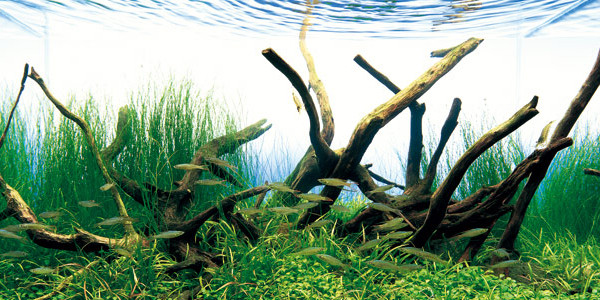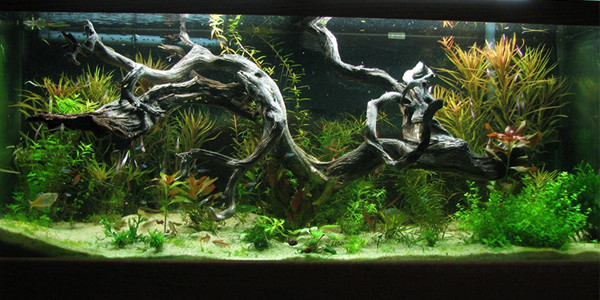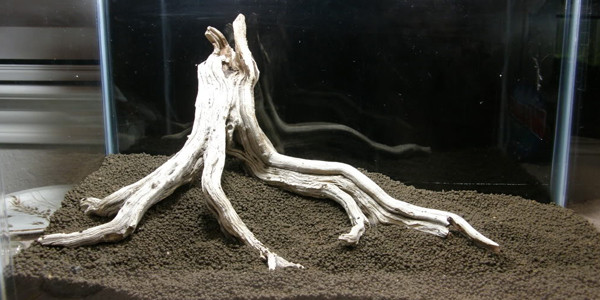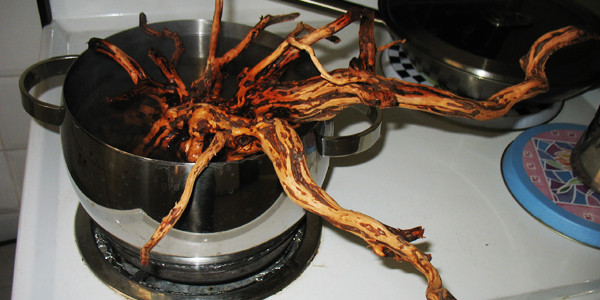Driftwood may be something you expect next to the ocean, but it’s an essential part in many aquariums too. While driftwood is an appealing decorative item, it’s also part of a healthy ecosystem as many animals rely on it for shelter, while plants, mosses, and ferns root in it and are nourished by the slow decay of the driftwood.

Adding driftwood to your aquarium isn’t as simple as collecting some on a day at the beach and throwing it in the tank. Here are the answers to all your “driftwood for your tank” questions.
Table of Contents
What Is Aquarium Driftwood?
Natural driftwood is a piece of wood that has been broken off from a tree by winds or flooding and washed onto the beach or ashore. In an aquarium, driftwood may be naturally sourced, or it can be manufactured from reclaimed wood. It is used as a decoration, a food source for the inhabitants of the tank, or a substrate for mosses and algae.
Driftwood can be a major nuisance in some towns that border waterways. However, the driftwood provides food and cover for some fish, birds, and other creatures living near or in water, as it can also float in the ocean or rivers.
When it comes to your aquarium, let driftwood float on the surface of the water or sink it to the bottom of the tank by soaking it in the aquarium over a period of time or by attaching a piece of slate to the driftwood with a stainless steel screw. After it sinks, you can cover the slate with gravel, rocks, or aquatic plants.

Different Types of Aquarium Driftwood
Standard driftwood is the most easily found almost anywhere and it’s the only driftwood that floats. Through erosion, branches of tree trunks form into driftwood and can be found in all sizes and shapes. When it comes to your aquarium, allowing driftwood to float on the surface of the water or sink to the bottom by soaking in the aquarium over a period of time or attaching a piece of slate to the driftwood with a stainless steel screw. After it sinks, you can cover the slate with gravel, rocks, or aquatic plants.
Savannah Root is a driftwood that sinks by itself and does not need to be mounted to anything else. It will make a perfect addition to any aquarium.
African driftwood has the appearance of normal standard driftwood, though it is self-sinking because it is hollow, thus the water helps it sink. This type of driftwood is usually hundreds of years old, making its origin a vast topic for discussion though it is also a bit pricier than normal driftwood.
Malaysian driftwood will work perfect if you want to attach aquarium plants because it does not float so it will also look great in any aquarium.

How Can Driftwood be Useful?
Shipworms, bacteria, and gribble worms can cause driftwood to decompose, transforming it into nutrients that are reintroduced to the natural food chain in the oceans and rivers. In your aquarium, it’s ideal to provide minerals and bioavailable nutrients to the fish, crustaceans, and plants of your tank.
You can use driftwood to add dimension to your tank, and in a tank planted with floating plants, driftwood can help anchor these, as well as provide shelter for smaller fish or fries that need a nursery area to safely develop.
Driftwood can become the centerpiece of your underwater landscape, and you can create amazing designs with a hidden under-tank light that casts up to illuminate the driftwood pieces. Floating driftwood can be used as a basking platform for turtles, as they can climb onto it and dry off while they soak up the sunlight.
Recommended Aquarium Driftwood
Preparing Driftwood for an Aquarium
Before you can use your driftwood in your aquarium, prepare it and make sure there are no unwanted guests burrowed into the wood or poisons soaked into the grain that could be harmful to your fish tank.
If your piece of driftwood is small enough, you can boil it for fifteen minutes, rinse it, and repeat a second time to make sure that it has been cleaned and sanitized.
After it has cooled down, you can drain it and use it in your aquarium—there’s no need to dry it before placing it in your aquarium. Avoid using chemicals like soap to clean the driftwood, as it will leech into the wood and contaminate your tank.

Why Should We Use It?
Not only is aquarium driftwood a stylish ornament or feature in your tank, but it can also be a hideaway for fish or other aquatic creatures. Endless possibilities exist when it comes to attaching aquarium plantations to driftwood.
Driftwood in your tank can be the base for an underwater sand or gravel dune. The most recommended driftwood for an aquarium is self-sinking driftwood.
Always remember to keep an eye on your tank pH levels, as driftwood can lower pH, making the water softer. While some fish thrive in a “gray water” situation with a lower pH, many won’t survive it.
Top 5 Aquarium Driftwoods
Here’s a quick overview of the top five aquarium driftwoods on the market that we recommend you consider adding to your aquarium.
1. Majoywoo Natural Large Coral Driftwood for Aquarium
Order your set of two driftwood pieces that are ideal for a tank of 20 gallons or more in size. The two pieces are each unique as these are genuine driftwood items that are cut to size. While the wood is smooth, it hasn’t been prepared, so you will have to boil the wood according to the manufacturer’s guide.
Once the wood has been boiled and all tannins have been removed from the wood, you can add it to your tank for a stunning focal point and to help establish your plants and animals.
The wood is fairly light at 1.15 pounds, and it may still take a while to sink once it’s been boiled. Alternatively, attach it to the tank bottom or weigh it down for a few days until it settles to the bottom of the tank. Don’t glue it in place, as most glues aren’t safe for fish and plants.
The only catch is that you don’t know what your two pieces of driftwood will look like before they arrive, so it’s a little like receiving a lucky packet gift when you order.
2. WDEFUN Driftwood for Aquarium Decor
This set of seven driftwood sections is a stunning addition to your smaller-size aquariums. Each piece has been selected for maximum appeal and spiderwood appearance.
Smaller packs are available with single or fewer pieces inside that are larger in size to suit your tank. Scatter the pieces to create your own underwater jungle with the tree branches.
Seven pieces weigh in at 1.39 pounds. When you boil the wood in preparation for adding it to your tank, the weight will increase, helping to sink the wood to the tank bottom. Boil the wood for three sessions of an hour each, adding salt and soda to help eliminate any tannins and harmful substances.
Also Read: Java Moss: How To Make It Grow, Design Ideas, And More
3. Hamiledyi Aquarium Driftwood
Add dimension to your tank with the three pieces of coral driftwood that are in a set. With a set of 1.08 pounds, you can add that special character to your tank. The wood is sourced from nature, but you should first boil the driftwood before you add it to your tank.
It is not recommended that any artificial material is glued to the wood. Nor should you use steel nails to attach anything to the wood. These will pollute the water’s pH and release harmful substances into the tank water. Instead, use the driftwood pieces to naturally establish plants and create stunning aquascapes.
4. LYPHARD AQUARIUMS Natural Large Driftwood for Aquarium Decor
If you don’t want many smaller pieces of driftwood, then this is the piece for you. At 9-14 inches in length, this is sure to be the talking piece of your aquarium. The natural hardwood is ideal with its craggy appearance, allowing smaller fish to hide and moss to root.
Due to the size of the piece, it’s recommended that you soak the wood for a few days, then boil, then soak again and boil once more before adding it to your tank. Remember to use fresh water each time you boil and soak the wood.
This piece is quite heavy at 4.76 pounds, so it will sink directly to the bottom with no need to weigh it down.
5. Dr. Moss Aquarium Small Malaysian Driftwood Luxurious Set
For those who specifically want Malaysian driftwood, which doesn’t float, this is a great set of two driftwood pieces to use for your tank. These pieces are reclaimed from nature, so you will have to sterilize the wood with the traditional soaking and boiling.
Note, this is a set for a smaller size aquarium as the pieces are small with a maximum length of seven inches. The wood is also lightweight at 6.4 ounces. It’s a good deal for the set, and the rough appearance works well in most aquariums.
Also Read: Growing Dwarf Baby Tears On Driftwood
Final Drift
Before placing a piece of driftwood in your aquarium, make sure you sanitize it correctly, or else it can cause more damage than good.
If you are still not sure of what kind of driftwood you have or what to do before adding it to your tank, contact your local public aquarium or pet store for more detailed information.
No related posts.






5 thoughts on “Aquarium Driftwood for Your Tank”
Ordered Malaysian driftwood online and have boiled it for at least 15 minutes two times. Just hope all the tannis are out. I do not want brown water aquarium. Of course my betta may feel more at home in brown water.
I found some driftwood in brackish water boiled it and its now in my tank but the water seems brownish will this ever clear with water changes?
It should clear with a a filter system with charcoal.
I have collected driftwood for years off the California coast. Going to soak for 24 hours then boil and rinse, two times. We shall see how it works. Not going to use slate though,(to sink it),as it has sharp edging. Do not think it would be good for the Oscars.
Interesting information. I found some driftwood in a brackish lake. So how can I use it in my tank and still be fish safe?